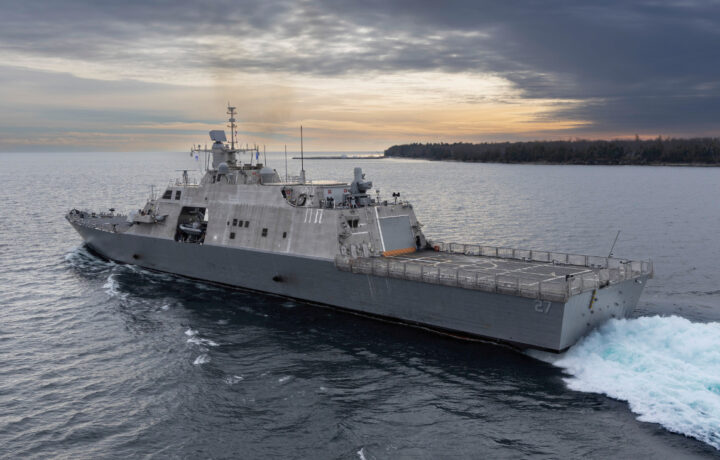This week, Lockheed Martin subsidiary Fincantieri Marinette Marine delivered what will likely be among the last Freedom-class variant Littoral Combat Ships (LCS) to the United States Navy. USS Nantucket (LCS-27) was accepted at the company’s shipyard in Marinette, WI.
According to the shipbuilder, the delivery followed the successful completion of Acceptance Trials last December, and the warship will be officially commissioned later this year, with her homeport slated to be Mayport, FL.
“The future USS Nantucket serves as a shining example of the perseverance of the United States maritime industrial base and shows that the partnership we have with industry is built to last,” said Capt. Matthew Lehmann, program manager of the Littoral Combat Ship program office.
LCS-27 is the third U.S. Navy warship to be named for the island that is 30 miles south of Cape Cod. The first was the Passaic-class coastal monitor that saw service with the U.S. Navy during the American Civil War, participating in the attack on Confederate forts in Charleston Harbor. The second was the IX-18, a screw steamer that served with the U.S. Navy for nearly 65 years – beginning as a gunboat, and later as a training ship with the Massachusetts Maritime Academy.
Two to Go With the Freedom-class
With the delivery of the LCS-27, there are just two more Freedom-class LCSs now under construction at the Fincantieri Marinette Marine shipyard, including the future USS Beloit (LCS-29), which is scheduled to be delivered later this summer; and USS Cleveland (LCS-31), the final warship of the class. The latter vessel is in the final stages of construction and is on track for a handover before the end of the year.
The U.S. Navy’s LCS vessels consist of two variants, which include the Freedom-class, a monohull warship built by a team led by Lockheed Martin (for the odd-numbered ships); and the trimaran-hulled Independence-class variant team led by Austal USA (for the even-numbered ships).
The USS Pierre (LCS-38), the final Independence-class, is now under construction in Mobile, AL. She was christened this past May and is scheduled for delivery in fiscal year 2025 (FY25), and will be homeported in San Diego, California after entering service by this time next year.
New Vessels Enter Service As Old Ones Retired
Critics of the LCS program have contended that it is a massive hole in the water for the U.S. Navy. At issue is that the program began when the U.S. military was engaged in the Global War on Terror (GWOT) following the September 11, 2001 attacks. The LCS was seen as ideal for combating missile-firing boats, and even small submarines, while it was envisioned that the stealthy surface combatants could be capable of defeating anti-access and asymmetric threats in littoral or near-shore waters.
It was also unique in that the sea service opted for two distinctive classes of vessels – each slightly smaller than the Oliver Hazard Perry-class frigate. The vessels were meant to emphasize speed and could utilize flexible mission modules while operating where larger warships could not.
However, the warships have been prone to breakdowns, and after Congress cut the funding for the mission modules that could have provided the LCS with its necessary capabilities, the U.S. Navy was left with a lightly armed platform not suited to a conflict with near-peer adversaries.
Sailors were so critical of the vessels, that they were dubbed the “Little Crappy Ships.”
As a result of the problems, the U.S. Navy began to retire the oldest LCS last year, despite those ships serving in the fleet for less than half of the expected 25-year lifespan. There have been calls to transfer the vessels to U.S. allies and partner nations, including those in South America where the LCS could be employed in a drug interdiction role – or possibly in the Middle East.
New LCS Role – Mine Countersweeper
It was in April that the U.S. Navy began testing the Mine Countermeasures Mission Package (MCM MP) aboard the Independence-class USS Canberra (LCS-30). The MCM package is made up of an integrated suite of unmanned maritime systems and sensors, and it can be used to locate, identify, and destroy mines in the littorals while increasing the ship’s standoff distance from the threat area.
It remains unclear if the MCM MP will be employed on the Freedom-class variants, but there have been calls for the LCS with the module to replace the aging Avenger-class mine countermeasure ships (MCS) now in service.




